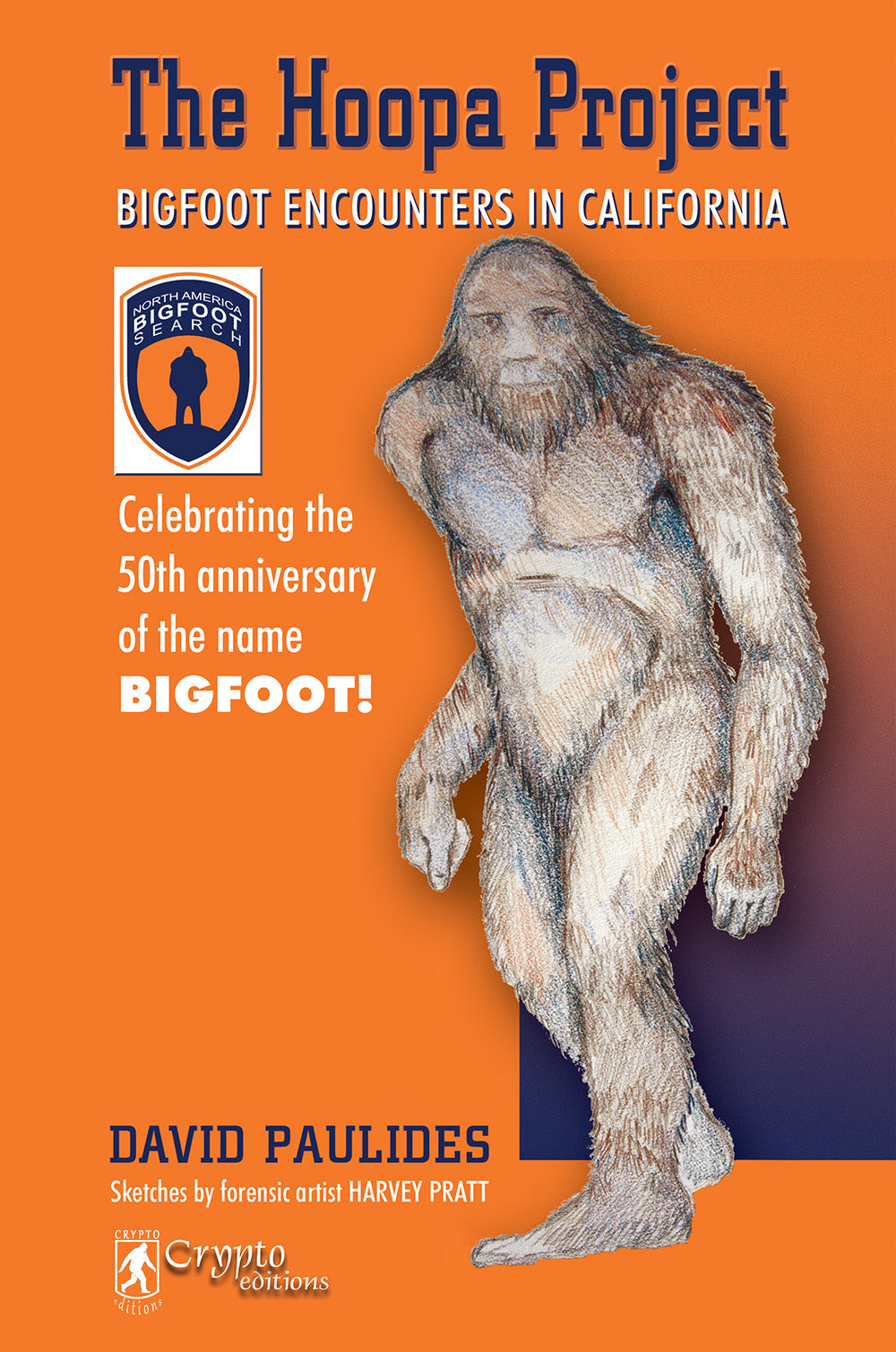

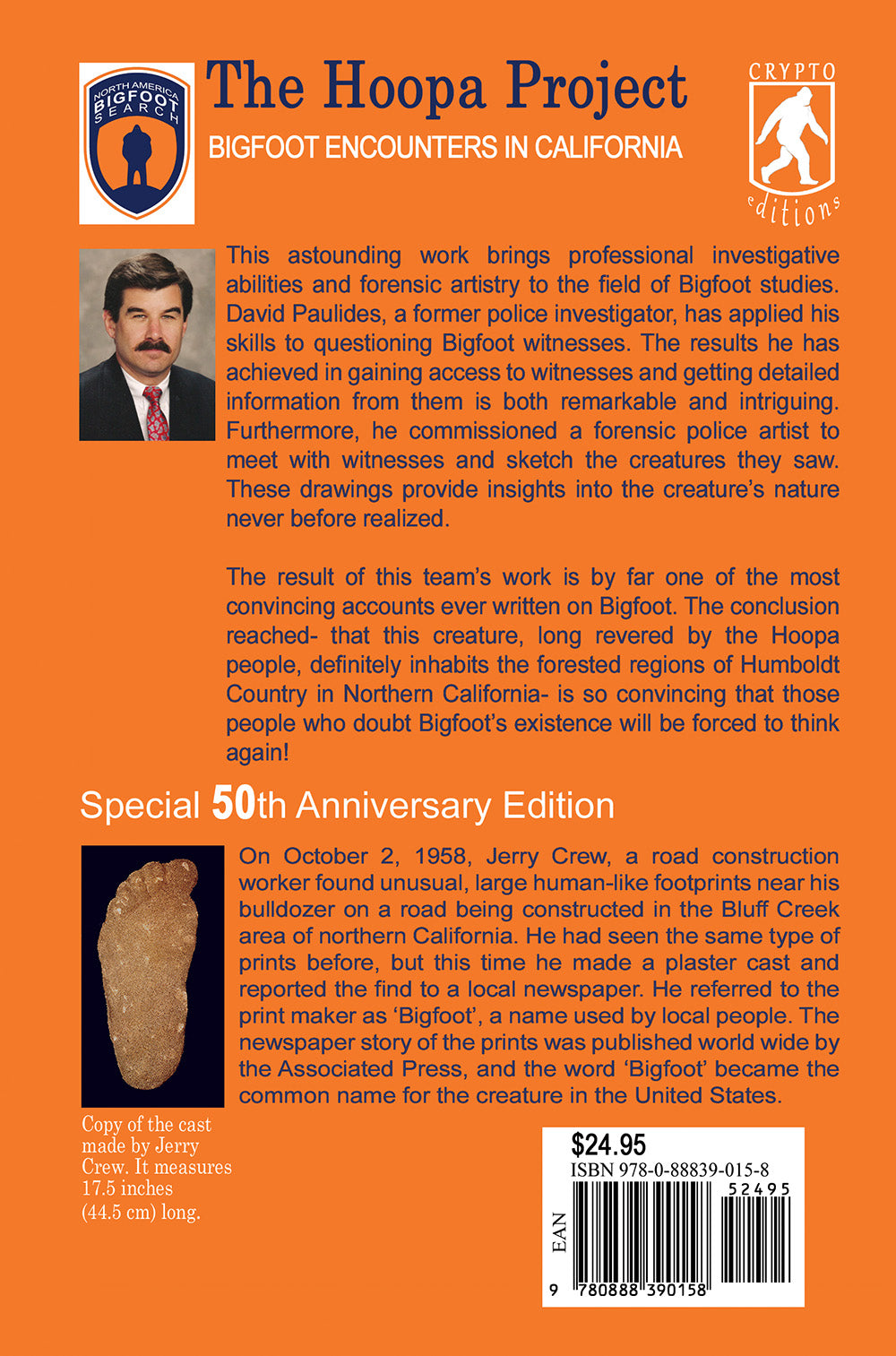
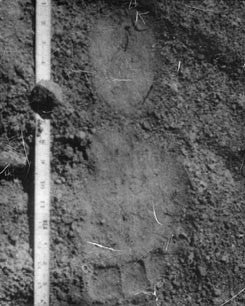

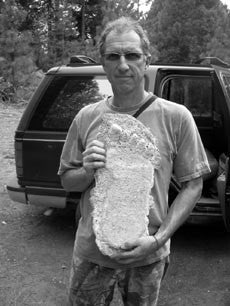
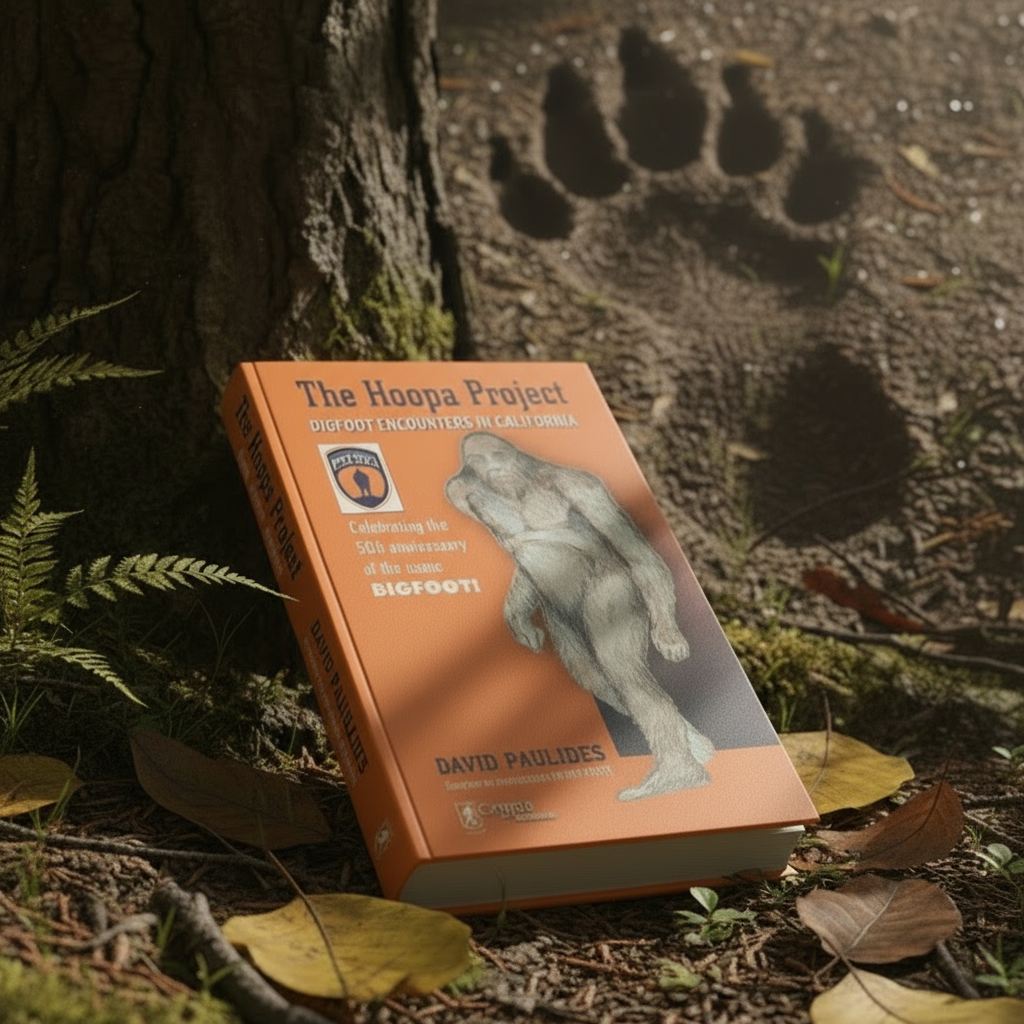
Hoopa Project: bigfoot encounters in California
Details
By: Paulides, David
ISBN-13: 978-0-88839-653-2 (2008 Colour Ed.)
ISBN-13: 978-0-88839-015-8 (2017 B&W Reprint)
Binding: Trade Paper
Size: 8.5" X 5.5"
Pages: 336
Photos: 66
Illustrations: 71
Publication Date: 06-Nov-2017
Description
PR Highlights: Skeptics will be forced to think again!
PHOTO Highlights: 124 images including illustrations & maps
Sample Chapter
Description: This astounding work brings professional investigative abilities and forensic artistry to the field of Bigfoot studies. **NEW: the 'Bigfoot Sightings Map' lists all of the Bigfoot sightings and encounters that are investigated in this book **
This astounding work brings professional investigative abilities and forensic artistry to the field of Bigfoot studies. David Paulides, a former police investigator, has applied his skills to questioning Bigfoot witnesses. The results he has achieved in gaining access to witnesses and getting detailed information from them is both remarkable and intriguing. Furthermore, he commissioned a forensic police artist to meet with witnesses and sketch the creatures they saw. These drawings provide insights into the creature's nature never before realized. The result of this team's work is by far one of the most convincing accounts ever written on Bigfoot. The conclusion reached - that this creature, long revered by the Hoopa people, definitely inhabits the forested regions of Humboldt County in Northern California - is so convincing that those people who doubt Bigfoot's existence will be forced to think again!
Special 50th Anniversary Edition
On October 2, 1958, Jerry Crew, a road construction worker, found unusual, large human-like footprints near his bulldozer on a road being constructed in the Bluff Creek area of northern California. He had seen the same type of prints before, but this time he made a plaster cast and reported the find to a local newspaper. He referred to the print maker as Bigfoot, a name used by local people. The newspaper story of the prints was published world wide by the Associated Press, and the word Bigfoot became the common name for the creature in the United States.
Author Biography
Dave Paulides holds two degrees from the University of San Francisco, and has a professional background that includes twenty years in law enforcement and senior executive positions in the technology sector. A boyhood camping experience with his father in the late 1960s sparked his interest in Bigfoot. In 2004 he formed North America Bigfoot Search where his investigative and analytical experience were invaluable in researching Bigfoot sightings. He spent two years living among the Hoopa tribal members, listening to and recording their Bigfoot stories. The Hoopa Project is his first book, based upon his experiences in the Bluff Creek area of Northern California. Harvey Pratt was educated at the University of Central Oklahoma and Oklahoma State University, and the Federal Bureau of Investigation. During his forty-year career in law enforcement he was involved in many high-profile investigations, including the Green River killer, BTK killer, Ted Bundy, the I-5 killer, and the Murrah Federal Building bombing. Harvey is a highly skilled forensic sketch artist specializing in witness descriptive drawing, skull tracing, age progression, soft tissue reconstruction, and photo restoration. Harvey is a member of the Cheyenne and Arapaho Tribes and is recognized as one of the traditional Cheyenne Peace Chiefs.
Book Reviews
Bigfoot Newsletter Online
www.bigfootencounters.com
Review by Bobbie Short
November 2008 Newsletter #219
The Hoopa Project, a new book by Dave Paulides is receiving rave reviews the likes of which I have not seen before in BF books. Since the last newsletter, these comments:
Book of the year! A must read! Excellent read, we enjoyed it. ...best realistic BF sketches. Paulides did his homework. Damn good. ...who is this Paulides guy? He writes one helluva book. We recommend it highly.
Most comments from readers who have seen a Bigfoot are raving on re: the human likenesses Harvey Pratt was able to capture in his sketches. Of course that is a feature I've been vocal about for thirteen years.
BigfootSightings
http://www.squidoo.com/bigfootsightings
Review by Linda Martin
October 26, 2008
Bigfoot - My Neighbor?
I've always been intrigued by the idea of Bigfoot, but it wasn't until 2005 that I decided to study the phenomena. I've never seen Bigfoot, but I live in a small town in the middle of a huge forest in Northern California, and lots of people around here say they may have seen one. My town has businesses named after Bigfoot, statues of Bigfoot, and huge footprints painted on the sidewalks in front of a few businesses. Yet nobody here, until now, has put this information together, to try to prove or disprove the town's claim to fame. During the past few years I've heard plenty of local Bigfoot stories, and have heard from people in other parts of the country who claim to have seen Bigfoot too. I've collected information on my blog, Bigfoot Sightings. Please visit http://bigfootsightings.org/ for a detailed review of The Hoopa Project.
The Daily Triplicate, Crescent City, California
Review by Matthew C. Durkee
August 9, 2008
For Bigfoot believers and skeptics alike, a new book about sightings in the Hoopa area raises a number of challenging questions. The Hoopa Project by David Paulides is the first major research report of North American Bigfoot Search, an organization formed in 2004 by a group of Silicon Valley executives curious about prior experiences they'd had in Northern California forests. One significant difference between NABS and every other Bigfoot organization is our dedication to stay on a regional project until every possible angle of every sighting has been researched, witnesses interviewed, locations and food sources understood, and an extensive list of variables answered, the NABS Web site says. Paulides is the public face of NABS, which he says has members of the academic community who don't want to be exposed to ridicule by publically supporting research into the controversial topic. NABS' initial project was to gather every recorded report of a Bigfoot sighting in the four-county region of Del Norte, Humboldt, Trinity and Siskiyou counties (as well as southern portions of Jackson and Curry counties in Oregon).
We plotted those locations on a map, Paulides told The Triplicate. This was to give us a sense of the population, migratory process, etc. When we showed this to people, they said this has never been done before. The map helped NABS choose a location to focus its research efforts - Hoopa Valley in northern Humboldt County. But with investigative skills developed over 20 years in law enforcement, Paulides brought a new approach to Bigfoot research - good old-fashioned detective work. For three years, Paulides made frequent trips to Hoopa to interview locals who experienced sightings or significant interactions. It wasn't an easy thing to do. I originally went into the city and met a couple of Hoopa police officers. I think that former alliance helped me get my foot in the door at that level. One of these guys knew someone prominent in the community and directed me to them, and from there it took off very, very slowly. One by one, Paulides gained the trust of his interview subjects, and often they were able to introduce him to others with Bigfoot sightings and incidents. Paulides also found reports by canvassing rural neighborhoods where sightings were more common. He interviewed them not unlike witnesses to a crime are interviewed, eliciting as many details as possible and trying to assess their reliability. On later trips, Paulides revisited his subjects with written reports of their interviews and asked them to sign it as an affidavit affirming its accuracy.
Paulides brought in Harvey Pratt, an FBI-trained forensic sketch artist with years of law enforcement experience in Oklahoma. A member of the Cheyenne and Arapahoe tribes, Pratt's Native American background was helpful in gaining rapport with the primarily Hoopa tribal population in the valley. The bulk of The Hoopa Project is detailed reports of 16 incidents and 33 sightings in the Hoopa area, as well as forensic sketches of most of the sightings. The stories and pictures offer at least two important developments in Bigfoot research. One, they demonstrate that probably the vast majority of potential sightings go unreported. Many reports in the book came from witnesses who do not make a habit of sharing their experiences. Often, these people were professionals in fields such as teaching and forest management and some were tribal leaders, including one former Hoopa tribal councilwoman. They did not approach Paulides - they were approached by others who had already come to trust him. Paulides says he understands the hesitation to come forward. Coming from a police perspective, 50 percent of all rapes are not reported. Let's think about why that is, Paulides says. They're humiliated, embarrassed, intimidated by the legal process and don't want to come forward. A lot of the same issues apply to bigfoot. They don't want to be ridiculed or downtrodden by the community, so a lot of people shy away from anything that would draw ridicule. But the more you talk to people in the community, the more you see how prominent it is. Paulides says he's discussed this issue with others members of NABS, and they estimate that as many as 80 percent of all sightings go unreported. But for Paulides, the most interesting piece of information produced by the project was the overwhelming consensus about Bigfoot's appearance, which runs counter to popular modern depictions of the creature.
Dmitri Bayanov
International Center of Hominology,
Moscow, Russia, January 12, 2009
I finished reading the David Paulides book, The Hoopa Project: Bigfoot Encounters In California, Hancock House Publishers, 2008, gifted to me by Investigator X, and I fully concur with her high assessment of the book. It is a valuable addition to a number of volumes aimed at answering the question: Do bigfoot exist? Even if the other volumes did not exist, this work is convincing enough for any open-minded investigator in answering the question positively. It is noteworthy that unlike other BF pro-existence studies, this one is based solely on generally misjudged and undervalued anecdotal evidence. Footprints, hairs, scat, DNA, vocalizations, their discussion and analyses are not to be found in this book. The author only gives a short list of such evidence collected in North America. Instead there are many BF sketches done by a forensic artist on the basis of sighting reports by witnesses. And it is just eyewitnesses who are the main characters of the book which is its important and distinctive feature. As a former police investigator, the author is well equipped to understand the paramount role of the witness in our field of study and uses it in a professional way.

